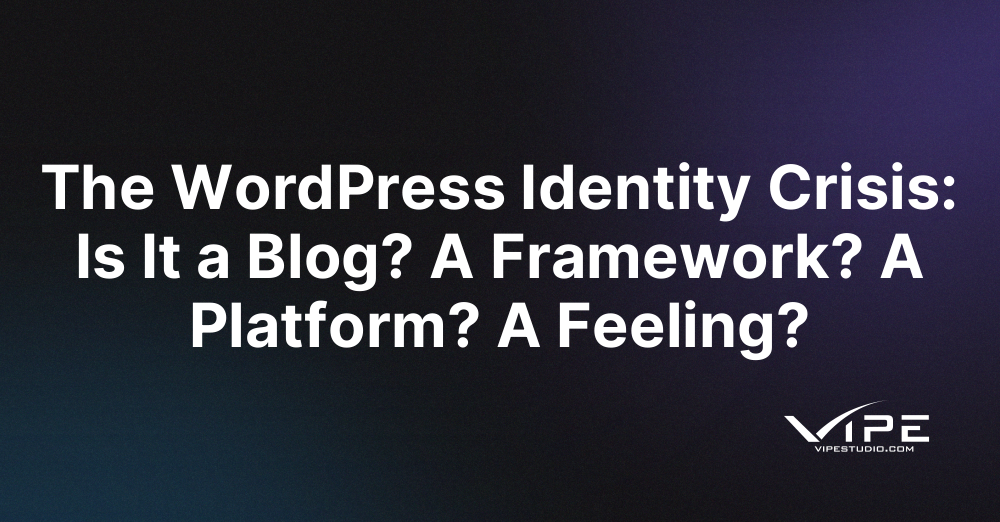24.10.2025
WordPress Development
The WordPress Identity Crisis: Is It a Blog? A Framework? A Platform? A Feeling?
READING TIME: MIN
Table of Content
Introduction: Naming the Unnameable
WordPress has existed for more than two decades, and in that time it has been called many things. For some, it will always be “just a blogging tool.” For others, it has grown into an all-encompassing content management system. Still others view it as a development framework, a digital business platform, or even a cultural movement. This multiplicity of identities has created what can only be described as an identity crisis. Is WordPress software? Infrastructure? A brand? Or is it a feeling – an experience of openness, empowerment, and belonging that transcends definitions?
This tension becomes even clearer when organizations explore building with WordPress. While some see it as a budget-friendly website solution, others use it as a foundation for complex applications, e-commerce engines, or digital communities. That diversity of use cases is part of its strength – but also the root of its existential confusion. Many teams, after struggling with its blurred lines, turn to external expertise – sometimes through a professional WordPress partner – to understand what WordPress can truly be for their specific needs.
WordPress as a Blog: The Origin Story
When WordPress launched in 2003, its mission was simple: make publishing online accessible to everyone. Its identity was rooted in blogging culture, where personal diaries and commentary sites formed the beating heart of the web. The default post structures, commenting system, and emphasis on chronological publishing reflected this heritage.
Even today, traces of this origin remain. The terminology of “posts” and “categories,” the default blog roll, and the focus on content publishing are legacies of the blogging era. For many small businesses and independent creators, WordPress still serves this primary role: an approachable, customizable blogging engine. Yet to describe it only in these terms is to ignore the radical transformation it has undergone since.
WordPress as a CMS: The Expansion of Scope
By the late 2000s, WordPress had evolved beyond blogging. It became a full-fledged content management system, supporting static pages, multimedia, complex menus, and customizable themes. Its plugin architecture gave developers the ability to extend it into virtually any kind of site, from portfolios to news portals.
This shift dramatically expanded its user base. Universities, corporations, and nonprofits adopted it not to blog, but to manage content at scale. Today, more than 40% of the web runs on WordPress, a statistic impossible to explain if we think of it as “just blogging.” The CMS identity – flexible, modular, accessible – was arguably the most transformative stage of its history.
WordPress as a Framework
As developers dug deeper into WordPress’s internals, another identity emerged: a development framework. Its core functions, hooks, and APIs allowed custom applications to be built on top of it. WooCommerce, one of the most successful e-commerce platforms in the world, is itself an extension of WordPress.
This framework identity is less visible to casual users but central to how agencies and developers perceive WordPress. For them, it is not just an off-the-shelf CMS but a foundation – a scaffolding upon which complex, bespoke applications can be constructed. In this light, WordPress resembles Laravel, Django, or Rails, except with an unparalleled global adoption curve and a vast ecosystem of ready-made components.
WordPress as a Platform
Beyond being software or framework, WordPress has become a platform in the economic sense. With millions of themes, plugins, service providers, and hosting companies built around it, WordPress powers a multi-billion-dollar industry. Freelancers, agencies, educators, and product vendors all depend on its ecosystem to make a living.
Calling WordPress a platform acknowledges its role as a marketplace. Developers do not just build on it – they build businesses through it. Events like WordCamps, commercial plugin marketplaces, and enterprise-level managed hosting are signs of its platform identity, which extends far beyond software into economy and culture.
WordPress as a Feeling
Perhaps the most intangible identity of WordPress is also the hardest to dismiss: it is a feeling. Open-source values, the commitment to democratizing publishing, and the communal rituals of meetups and WordCamps foster a sense of belonging that no proprietary software can replicate. WordPress is not merely technology – it is a culture.
This explains why debates over its identity matter so deeply to its community. To some, calling it a “blogging tool” feels reductive, even insulting. To others, positioning it purely as an enterprise CMS ignores its roots in personal expression. The feeling of WordPress – the sense that it empowers anyone to create and share online – is what unites its fragmented identities.
The Costs of an Identity Crisis
Yet this fluid identity comes with risks. Confusion among potential adopters can hinder decision-making. Businesses may underestimate its power by assuming it is “just for blogs.” Conversely, enterprises may be wary of its perceived amateur origins. Developers, meanwhile, can become frustrated with its quirks, comparing it unfavorably with “cleaner” modern frameworks.
This identity tension can even shape project outcomes. A website built with the assumption that WordPress is a blogging tool may miss opportunities for community-building, e-commerce, or application-level customization. Conversely, overcomplicating a simple project by treating WordPress like a heavy-duty enterprise system can waste time and resources.
Bridging Identities Through Practice
One way to resolve the identity crisis is to stop seeing these categories as mutually exclusive. WordPress is a blog, a CMS, a framework, a platform, and a feeling – all at once. The challenge lies not in pinning it down but in knowing which identity matters most for a given project. For a writer, its blogging tools are essential. For a retailer, its e-commerce integrations dominate. For a community, its cultural and participatory aspects matter most.
Agencies and developers who thrive in this space are those who embrace the fluidity. Instead of forcing WordPress into one box, they explore its many possibilities. It is often at this point – when projects demand both technical flexibility and cultural sensitivity – that teams look for collaboration with specialists, sometimes working with a WordPress-focused agency to unlock the best combination of identities for their goals.
Conclusion: Beyond Labels
The WordPress identity crisis is real, but perhaps it is less a crisis than a reflection of growth. Few technologies survive long enough to accumulate multiple, sometimes conflicting identities. That WordPress can be a blog, a CMS, a framework, a platform, and a cultural feeling – all at once – is evidence of its adaptability and resilience.
Rather than trying to fix its identity, the community and ecosystem may benefit more from embracing its plurality. WordPress is everything its users need it to be, and that elasticity has allowed it to thrive while countless competitors have faded. Its identity is not static; it is a mirror of its community, evolving with every contribution, every extension, and every new story told through its code.
Key Takeaways
- WordPress’s identity spans blogging, CMS, framework, platform, and culture.
- Its multiplicity is both a strength and a source of confusion.
- Perceptions of WordPress affect adoption, project scope, and outcomes.
- Specialists and agencies help reconcile its identities in practice.
- Rather than resolving the crisis, embracing pluralism may be the key.
More on The Topic
- Staging Sites That Reveal Organizational Blind Spots
- WordPress Performance Debt Nobody Talks About
- The Admin UX That Shapes Decisions
- Scaling WordPress Without Losing Culture
- WordPress 6.9 “Gene”: What This Release Really Changes
The content of this website is copyrighted and protected by Creative Commons 4.0.



